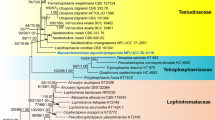Abstract
Phytoceratiomyxa osmundae, parasitic on fronds of Osmunda japonica var. sublancea in Taiwan, was described as a new genus and species in the Myxomycetes by Sawada in 1929. Our investigations on the type specimen, and related descriptions and illustrations of P. osmundae, revealed that this microorganism, originally identified as a myxomycete, was phenotypically identical with Mixia osmundae, which was transferred from the Ascomycota to the Basidiomycota based on the integrated analysis of molecules and morphology by Nishida et al. in 1995. In addition, a lectotype for Taphrina osmundae, the basionym of Mixia osmundae, is also designated. A nomenclatural proposal regarding the generic names Phytoceratiomyxa and Mixia related to this study will be published elsewhere.
Similar content being viewed by others

References
Aime MC, Matheny PB, Henk DA, Frieders EM, Nilsson RH, Pipenbring M, McLaughlin DJ, Szabo LJ, Begerow D, Sampaio JP, Bauer R, Weiss M, Oberwinkler F, Hibbett DS (2007 [“2006”]) An overview of the higher-level classification of Pucciniomycotina based on combined analyses of nuclear large and small subunit rDNA sequences. Mycologia 98:896–905
Bauer R, Begerow D, Sampaio JP, Weiss M, Oberwinkler F (2006) The simple-septate basidiomycetes: a synopsis. Mycol Prog 5:41–66
Benny GL, O’Donnell K (2000) Amoebidium parasiticum is a protozoan, not a trichomycete. Mycologia 92:1133–1137
Benny GL, Humber RA, Morton JB (2001) Zygomycota: Zygomycetes. In: McLaughlin DJ, McLaughlin EG, Lemke PA (eds) The Mycota, vol 7 (Systematics and evolution, part A). Springer, Berlin, pp 113–146
Bills GF, Foster MS (2004) Formulae for selected materials used to isolate and study fungi and fungal allies. In: Mueller GM, Bills GF, Foster MS (eds) Biodiversity of fungi: inventory and monitoring methods. Elsevier, Amsterdam, pp 595–618
Edman JC, Kovacs JA, Masur H, Santi DV, Elwood HJ, Sogin ML (1988) Ribosomal RNA sequence shows Pneumocystis carinii to be a member of the fungi. Nature (Lond) 334:519–522
Greuter W, Brummitt RK, Farr E, Kilian N, Kirk PM, Silva PC (1993) Names in current use for extant plant genera. Regnum Vegetabile 129:1–1464
Hibbett DS, Binder M, Bischoff JF, Blackwell M, Cannon PF, Erikkson OE, Huhndorf S, James T, Kirk PM, Lücking R, Lumbsch HT, Lutzoni F, Matheny PB, McLaughlin DJ, Powell MJ, Redhead S, Schoch CL, Spatafora JW, Stalpers JA, Vilgalys R, Aime MC, Artroot A, Bauer R, Begerow D, Benny GL, Castlebury LA, Crous PW, Dai Y-C, Gams W, Geiser DM, Griffith GW, Gueidan C, Hawksworth DL, Hestmark G, Hosaka K, Humber RA, Hyde KD, Ironside JE, Kõljalg U, Kurtzman CP, Larsson K-H, Lichtwardt R, Longcore J, Miadlikowska J, Miller A, Moncarvo J-M, Mozley-Standridge S, Oberwinkler F, Parmasto E, Reeb V, Rogers JD, Roux C, Ryvarden L, Sampaio JP, Schüßler A, Sugiyama J, Thorn RG, Tibell L, Untereiner WA, Walker C, Wang Z, Weir A, Weiss M, White MM, Winka K, Yao Y-J, Zang N (2007) A higher-level phylogenetic classification of the Fungi. Mycol Res 111:509–547
Ito S (1964) Mycological flora of Japan, vol 3 (Ascomycetes), no. 1 (Saccharomycetales, Cryptococcales, Taphrinales). Yokendo, Tokyo, pp 204–206
Kirk PM, Cannon PF, David JC, Stalpers JA (2001) Ainsworth and Bisby’s dictionary of the fungi, 9th edn. CAB International, Wallingford
Kramer CL (1959 [“1958”]) A new genus in the Protomycetaceae. Mycologia 50:916–926
Kramer CL (1987) The Taphrinales. In: deHoog GS, Smith MT, Weijman ACM (eds) The expanding realm of yeast-like fungi. Elsevier, Amsterdam, pp 151–166
McNeill J, Barrie FR, Burdet HM, Demoulin V, Hawksworth DL, Marhold K, Nicolson DH, Prado J, Silva PC, Skog JE, Wiersema JH, Turland NJ (2006) International code of botanical nomenclature (Vienna code). ARG Gantner Verlag, Ruggell, Liechtenstein
Mix AJ (1947) Taphrina osmundae Nishida and Taphrina higginsii sp. nov. Mycologia 39:71–76
Mix AJ (1949) A monograph of the genus Taphrina. Univ Kans Sci Bull 33:3–167
Nishida H, Ando K, Ando Y, Hirata A, Sugiyama J (1995) Mixia osmundae: transfer from the Ascomycota to the Basidiomycota based on evidence from molecules and morphology. Can J Bot 73(suppl 1):S660–S666
Nishida T (1911) A contribution to the monograph of the parasitic Exoascaceae of Japan (in Japanese with English summary). In: Takahashi Y (ed) Collection of botanical papers presented to Prof. Dr. Kingo Miyabe on the occasion of the twenty-fifth anniversary of his academic service by his friends and pupils [the title is abbreviated as ‘Miyabe Festschrift’]. Rokumeikan, Tokyo, pp 157–212, pls 15–19
Sawada K (1929) Fungi from Taiwan (no. 27). Trans Nat Hist Soc Formosa 19(100):31–39
Sawada K (1931) Reports on Formosan fungi. Part 5. Rep Central Res Inst Formosan Gov No. 51, pp 11–12, pl 1 (figs. 1–12), pl 5 (photos I–II)
Sawada K (1959) Descriptive catalogue of Taiwan (Formosan) fungi. Part 11 (Imazeki R, Hiratsuka N, Asuyama H, eds). The College of Agriculture, National Taiwan University, Taipei
Sugiyama J, Hosaka K, Suh S-O (2007 [“2006”]) Early diverging Ascomycota: phylogenetic divergence and related evolutionary enigmas. Mycologia 98:996–1005
Tanabe Y, Watanabe MM, Sugiyama J (2005) Evolutionary relationships among basal fungi (Chytridiomycota and Zygomycota): insights from molecular phylogenetics. J Gen Appl Microbiol 51:267–276
Author information
Authors and Affiliations
Corresponding author
About this article
Cite this article
Sugiyama, J., Katumoto, K. Identity of the plasmodial slime mold Phytoceratiomyxa osmundae and the lectotypification of Taphrina osmundae, the basionym of Mixia osmundae . Mycoscience 49, 192–198 (2008). https://doi.org/10.1007/s10267-008-0402-z
Received:
Accepted:
Published:
Issue Date:
DOI: https://doi.org/10.1007/s10267-008-0402-z



